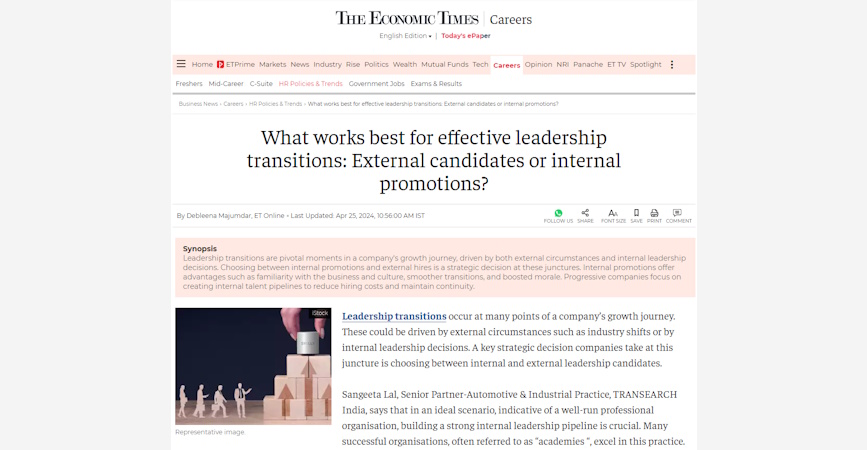
Synopsis: Leadership transitions are pivotal moments in a company’s growth journey, driven by both external circumstances and internal leadership decisions. Choosing between internal promotions and external hires is a strategic decision at these junctures. Internal promotions offer advantages such as familiarity with the business and culture, smoother transitions, and boosted morale. Progressive companies focus on creating internal talent pipelines to reduce hiring costs and maintain continuity.
Leadership transitions occur at many points of a company’s growth journey. These could be driven by external circumstances such as industry shifts or by internal leadership decisions. A key strategic decision companies take at this juncture is choosing between internal and external leadership candidates.
Sangeeta Lal, Senior Partner-Automotive & Industrial Practice, TRANSEARCH India, says that in an ideal scenario, indicative of a well-run professional organisation, building a strong internal leadership pipeline is crucial. Many successful organisations, often referred to as “academies “, excel in this practice. Examples are Unilever, GE, P&G, J&J, Tata Group and Aditya Birla Group. These organisations are renowned for their leadership development programmes and their rigour in succession planning.
Ramesh Alluri Reddy, CEO of TeamLease Degree Apprenticeship, underscores the criticality of this decision by saying that a leadership transition is a critical moment for any business as it marks a new chapter of growth and also requires adjustments in business, operations and strategic directions. The new leadership team will have its preferences — some may opt to recruit external talent with a proven track record and known acquaintances, while others may want to continue focusing on and promoting internal talent.
The case for internal promotions
Internal promotions offer distinct advantages, including familiarity with the business, customers and, more importantly, the company culture and values, Lal points out. Misalignments in culture often lead to massive failures, making cultural fit a crucial factor. Research, such as that conducted by McKinsey, highlights the correlation between effective culture management by CEOs and improved financial performance, underscoring the significance of the culture aspect.
Progressive companies always work on creating a talent pipeline to promote internally, says Ashutosh Khanna, Co founder and director, WalkWater Talent Advisors. This reduces the cost of and the time to hire, builds the morale and the engagement levels of the team, and maintains continuity in the business.
Lal says internal promotions also facilitate a smoother transition and can boost morale and demonstrate growth opportunities, fostering loyalty among employees. Hiring externally can disrupt team dynamics or create tension among employees who feel passed over for promotion. This can create fissures in the team and lead to resignations.
When external hiring could be a boon
Before deciding between internal promotion and external hiring, a company has to be clear if the role requires the incumbent to bring fresh thinking and challenge the status quo. The company needs to question if the external hire has better experience and competencies required to meet the objectives of the function.
Lal agrees that there are circumstances where external hires are deemed necessary, particularly when driving significant change or injecting a fresh perspective into the organisation. External candidates bring diverse experiences and global perspectives, especially when navigating change or driving innovation. Also, with their varied experience, they can bring different practices and approaches that could enhance the company’s competitiveness.
Reddy says the key is to strike a balance to ensure continuity, maximise productivity and support employee morale.
While there is no fixed formula, external candidates who are successful leaders tend to adopt a 90-day transition plan to oversee changes, factoring in organisational prerogatives. During the first 30 days, the focus should be on observing the current team’s dynamics, operational efficiency and senior leadership’s performance. This is followed by a period of assessment and potential restructuring. In the final 30 days, the new leadership team may initiate steps to address gaps internally or externally. However, the best approach often needs to factor in multiple variables, including external business environment, organisation’s culture, business challenges and long-term goals. The mark of a great leadership team is to make all stakeholders believe that they have their skin in the game, and have kept organisational success above any personal goals.
There is no doubt that effective succession planning is paramount for organisational success. Ultimately, successful organisations prioritise building leadership pipelines and may even tie performance evaluations and bonuses to this objective, recognising this as a key driver of sustained growth and profitability.
Source: The Economic Times








